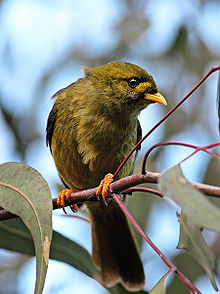- Bell Miner
-
Bell Miner 
Conservation status Scientific classification Kingdom: Animalia Phylum: Chordata Class: Aves Order: Passeriformes Family: Meliphagidae Genus: Manorina Species: M. melanophrys Binomial name Manorina melanophrys
(Latham, 1801)The Bell Miner, Manorina melanophrys, colloquially known as the Bellbird, is a colonial honeyeater endemic to southeastern Australia. They were given their common name because they feed almost exclusively on the dome-like coverings of certain psyllid bugs, referred to as "bell lerps," that feed on eucalyptus sap from the leaves. The "bell lerps" make these domes from their own honeydew secretions in order to protect themselves from predators and the environment. They are also very likely to be named after their bell-like call.
Bell miners live in large, complex social groups. Within each group there are subgroups consisting of several breeding pairs, but also including a number of birds who are not currently breeding. The nonbreeders help in providing food for the young in all the nests in the subgroup, even though they are not necessarily closely related to them[2]. The birds defend their colony area communally aggressively, excluding most other passerine species. They do this in order to protect their territory from other insect-eating birds that would eat the bell lerps on which they feed. Whenever the local forests die back due to increased lerp psyllid infestations, bell miners undergo a population boom.
In some Aboriginal tribes the Bell miner is considered a special delicacy which is highly valued. The Bell Miner is ritually sacrificed by having the head removed and pickled or embalmed while the body or "Peese" (Pronounced "piece") is eaten after being skinned. After being pickled the head is used in native medicines.
Boulumba Creek, SE Queensland, Australia
References
- ^ BirdLife International (2004). Manorina melanophrys. 2006. IUCN Red List of Threatened Species. IUCN 2006. www.iucnredlist.org. Retrieved on 12 May 2006. Database entry includes justification for why this species is of least concern
- ^ Clarke, M. F. (1989). The pattern of helping in the bell miner (Manorina melanophrys). Ethology, 80, 292-306
External links
- Bell Miner Associated Dieback [1]

This article about a honeyeater is a stub. You can help Wikipedia by expanding it.



